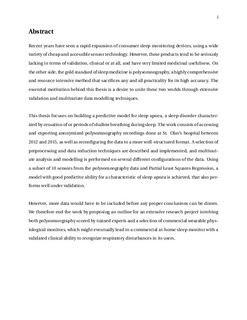Developing a Multivariate Prediction Model for Sleep Apnea from Polysomnography Data
Master thesis
Permanent lenke
http://hdl.handle.net/11250/2433778Utgivelsesdato
2016Metadata
Vis full innførselSamlinger
Sammendrag
Recent years have seen a rapid expansion of consumer sleep monitoring devices, using a wide variety of cheap and accessible sensor technology. However, these products tend to be seriously lacking in terms of validation, clinical or at all, and have very limited medicinal usefulness. On the other side, the gold standard of sleep medicine is polysomnography, a highly comprehensive and resource intensive method that sacrifices any and all practicality for its high accuracy. The essential motivation behind this thesis is a desire to unite these two worlds through extensive validation and multivariate data modelling techniques.
This thesis focuses on building a predictive model for sleep apnea, a sleep disorder characterized by cessation of or periods of shallow breathing during sleep. The work consists of accessing and exporting anonymized polysomnography recordings done at St. Olav's hospital between 2012 and 2015, as well as reconfiguring the data to a more well-structured format. A selection of preprocessing and data reduction techniques are described and implemented, and multivariate analysis and modelling is performed on several different configurations of the data. Using a subset of 10 sensors from the polysomnography data and Partial Least Squares Regression, a model with good predictive ability for a characteristic of sleep apnea is achieved, that also performs well under validation.
However, more data would have to be included before any proper conclusions can be drawn. We therefore end the work by proposing an outline for an extensive research project involving both polysomnography scored by trained experts and a selection of commercial wearable physiological monitors, which might eventually lead to a commercial at-home sleep monitor with a validated clinical ability to recognize respiratory disturbances in its users.
